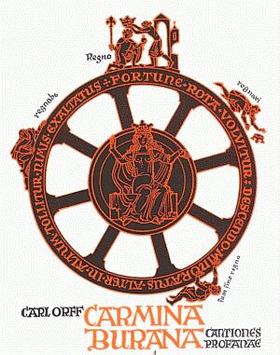http://en.wikipedia.org/wiki/Carmina_Burana_%28Orff%29 wrote:
<<Carmina Burana is a scenic cantata composed by Carl Orff in 1935 and 1936. It is based on 24 of the poems found in the medieval collection Carmina Burana. Its full Latin title is Carmina Burana: Cantiones profanæ cantoribus et choris cantandæ comitantibus instrumentis atque imaginibus magicis ("Songs of Beuern: Secular songs for singers and choruses to be sung together with instruments and magic images.") Carmina Burana is part of Trionfi, the musical triptych that also includes the cantata Catulli Carmina and Trionfo di Afrodite. The best-known movement is "Fortuna Imperatrix Mundi" ("O Fortuna") that opens and closes the piece.
Orff first encountered the text in John Addington Symonds's 1884 publication Wine, Women and Song[citation needed], which included English translations of 46 poems from the collection. Michel Hofmann, a young law student and Latin and Greek enthusiast, assisted Orff in the selection and organization of 24 of these poems into a libretto, mostly in Latin verse, with a small amount of Middle High German and Old Provençal. The selection covers a wide range of topics, as familiar in the 13th century as they are in the 21st century: the fickleness of fortune and wealth, the ephemeral nature of life, the joy of the return of Spring, and the pleasures and perils of drinking, gluttony, gambling and lust.
[edit] Reception
Carmina Burana was first staged in Frankfurt by the Frankfurt Opera on June 8, 1937. Shortly after the greatly successful premiere, Orff wrote the following letter to his publisher, Schott Music:
"Everything I have written to date, and which you have, unfortunately, printed, can be destroyed. With Carmina Burana, my collected works begin."
Several performances were repeated elsewhere in Germany. The Nazi regime was at first nervous about the erotic tone of some of the poems, but eventually embraced the piece. It became the most famous piece of music composed in Germany at the time. The popularity of the work continued to rise after the war, and by the 1960s Carmina Burana was well established as part of the international classic repertory.
Alex Ross wrote that
"the music itself commits no sins simply by being and remaining popular. That Carmina Burana has appeared in hundreds of films and television commercials is proof that it contains no diabolical message, indeed that it contains no message whatsoever."
The desire Orff expressed in the letter to his publisher has by and large been fulfilled: No other composition of his approaches its renown, as evidenced in both pop culture's appropriation of "O Fortuna" and the classical world's persistent programming and recording of the work. In the United States, Carmina Burana represents one of the few box office certainties in 20th-century music. Much of the compositional structure is based on the idea of the turning Fortuna Wheel. The drawing of the wheel found on the first page of the Burana Codex includes four phrases around the outside of the wheel:
"Regnabo, Regno, Regnavi, Sum sine regno".
(I shall reign, I reign, I have reigned, I am without a kingdom).
Within each scene, and sometimes within a single movement, the wheel of fortune turns, joy turning to bitterness, and hope turning to grief. "O Fortuna", the first poem in the Schmeller edition, completes this circle, forming a compositional frame for the work through being both the opening and closing movements.
 Equinox and Harvest Moon
Equinox and Harvest Moon



